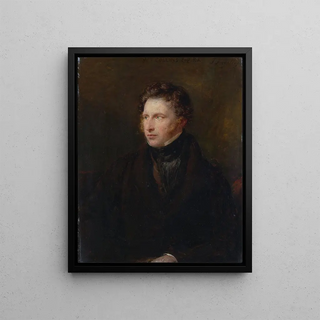Art print | William Collins R. A. - John Linnell


View from behind

Frame (optional)
William Collins R. A. art print - John Linnell – Captivating introduction
The William Collins R. A. art print - John Linnell is a true invitation to immerse oneself in the world of 19th-century British art. This piece, which delicately illustrates Collins's talent, echoes an era when landscape painting and realistic portraits experienced unprecedented growth. Gazing at this work, the viewer is transported into a silent dialogue between the artist and his model, a conversation imbued with respect and admiration. The soft light bathing the canvas, along with the meticulous details, awakens an insatiable curiosity in us for the history and emotions hidden behind each brushstroke.
Style and uniqueness of the work
William Collins's style is distinguished by his ability to capture the very essence of his subjects. In "John Linnell," the artist manages to transcend mere representation to offer an intimate and personal vision. The nuances of colors, ranging from warm tones to delicate shadows, create an atmosphere that is both serene and contemplative. Collins excels in the art of composition, skillfully balancing elements to guide the viewer's gaze through the work. This portrait is not only a reflection of Linnell but also an exploration of themes of friendship and artistic camaraderie. Every detail, from the contemplative look of the model to the texture of the clothing, testifies to attentive observation and deep empathy.
The artist and his influence
William Collins, a prominent member of the Royal Academy, left an indelible mark on the artistic landscape of his time. His humanist approach and sensitivity to everyday life stories inspired many contemporary artists. Collins managed to marry realism with a poetic touch, which allowed him to stand out in a milieu where romanticism and neoclassicism predominated. His ability to depict historical figures and scenes of ordinary life paved the way for a new way of viewing art, closer to human and social concerns. Through works like "John Linnell," he created a bridge between art and life, encouraging reflection on identity and interpersonal relationships.
A wall decoration of

Matte finish

View from behind

Frame (optional)
William Collins R. A. art print - John Linnell – Captivating introduction
The William Collins R. A. art print - John Linnell is a true invitation to immerse oneself in the world of 19th-century British art. This piece, which delicately illustrates Collins's talent, echoes an era when landscape painting and realistic portraits experienced unprecedented growth. Gazing at this work, the viewer is transported into a silent dialogue between the artist and his model, a conversation imbued with respect and admiration. The soft light bathing the canvas, along with the meticulous details, awakens an insatiable curiosity in us for the history and emotions hidden behind each brushstroke.
Style and uniqueness of the work
William Collins's style is distinguished by his ability to capture the very essence of his subjects. In "John Linnell," the artist manages to transcend mere representation to offer an intimate and personal vision. The nuances of colors, ranging from warm tones to delicate shadows, create an atmosphere that is both serene and contemplative. Collins excels in the art of composition, skillfully balancing elements to guide the viewer's gaze through the work. This portrait is not only a reflection of Linnell but also an exploration of themes of friendship and artistic camaraderie. Every detail, from the contemplative look of the model to the texture of the clothing, testifies to attentive observation and deep empathy.
The artist and his influence
William Collins, a prominent member of the Royal Academy, left an indelible mark on the artistic landscape of his time. His humanist approach and sensitivity to everyday life stories inspired many contemporary artists. Collins managed to marry realism with a poetic touch, which allowed him to stand out in a milieu where romanticism and neoclassicism predominated. His ability to depict historical figures and scenes of ordinary life paved the way for a new way of viewing art, closer to human and social concerns. Through works like "John Linnell," he created a bridge between art and life, encouraging reflection on identity and interpersonal relationships.
A wall decoration of






